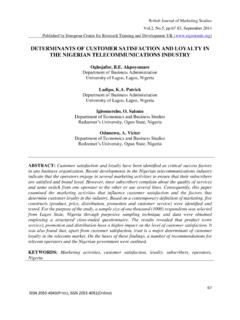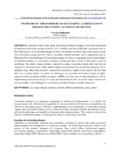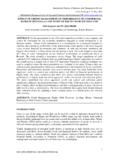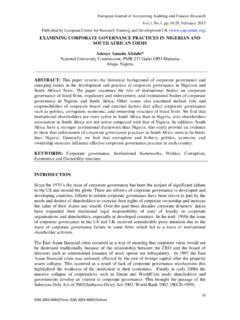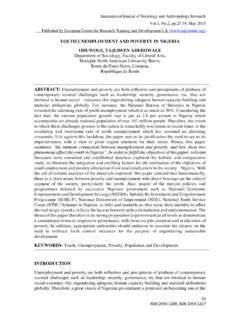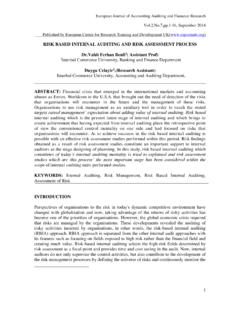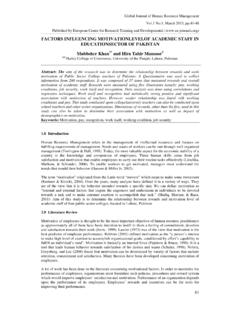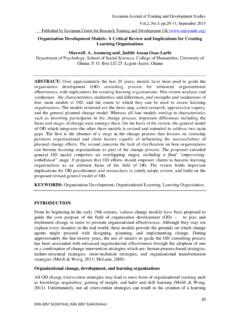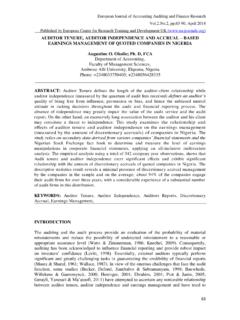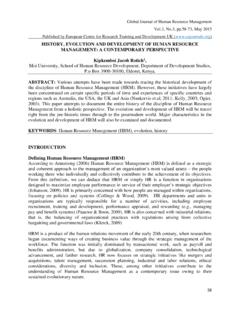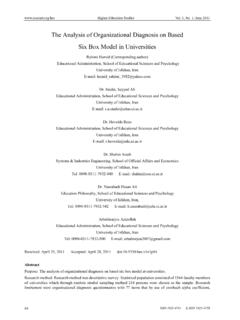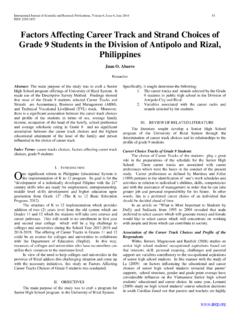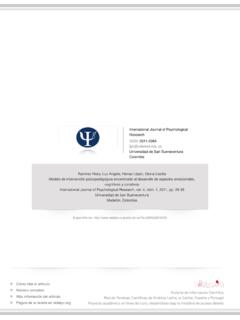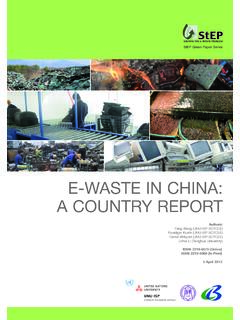Transcription of 7PS MARKETING MIX AND RETAIL BANK CUSTOMER …
1 British Journal of MARKETING Studies , , , june 2015 Published by European Centre for Research Training and Development UK ( ) 71 issn 2053-4043(Print), issn 2053-4051(Online) 7PS MARKETING MIX AND RETAIL bank CUSTOMER SATISFACTION IN NORTHEAST NIGERIA Haruna Isa Mohammad Department of Management Technology, Modibbo Adama University of Technology, Yola, Adamawa State, Nigeria. ABSTRACT: CUSTOMER satisfaction is a continuous process that management must engage in. This study analysed CUSTOMER satisfaction using 7Ps MARKETING mix elements to RETAIL bank customers in North east Nigeria. Objectives include examining product, price, place, promotion people, process and physical evidence as drivers of RETAIL bank CUSTOMER satisfaction.
2 Seven hypotheses were formulated to address the objectives. Data were collected from a sample size of 405 respondents comprising of academic and senior non-academic staff in universities and polytechnics in North east region of Nigeria through questionnaire administration. The study used correlation and regression analysis. The results found that product, process and physical evidence were significantly related to CUSTOMER satisfaction while price, promotion, place and people are not significantly related. It was also found that process is the most influential driver while price is the least influential. Finally, the study recommends that management should improve the MARKETING mix elements by applying the right mix to attract and retain customers.
3 KEYWORDS: 7Ps MARKETING Mix, CUSTOMER Satisfaction, RETAIL Banking, Northeast Nigeria INTRODUCTION Extant literatures have echoed a lot of studies in CUSTOMER satisfaction especially in using theories other than the 7Ps MARKETING mix. For example, Jamal and Naseer (2002), Awan Bukhari and Iqbal (2011) used SERVQUAL and Mamoun (2012) used 4Ps MARKETING mix in understanding drivers of CUSTOMER satisfaction. However, little studies have been conducted using the 7Ps MARKETING mix elements and most have not used 7Ps MARKETING mix in understanding CUSTOMER satisfaction in banks (Mohammad et al, 2012; Ala Eddin et al, 2013). The highly competitive Nigerian banking industry has made banks to be proactive in innovating different products, offering incentives, deploying new distribution platforms massively, indulging in promotional acts, training employees, building branches and increasing use of technology in order to satisfy customers.
4 Despite all these efforts, deposit money banks are faced with considerable MARKETING challenges such as pressure selling from MARKETING personnel especially if they want customers to open an account. There are also problems of weak services, long queues and huge crowds in the banking halls. Ogunnaike and Olaleke (2010), state that almost all Nigerian banks encounter similar problems in meeting customers expectations of services and customers satisfaction, ranging from problems of money transfer, long queues and huge crowds in the banking halls. Adeoye and Lawanson (2012), state that most of the long queues and huge crowds in the banking halls are as a result of breakdown of British Journal of MARKETING Studies , , , june 2015 Published by European Centre for Research Training and Development UK ( ) 72 issn 2053-4043(Print), issn 2053-4051(Online) computers and at times as a result of cashiers absconding from duty and passing the bulk to someone else.
5 Therefore, this study seeks to understand the impact of 7Ps MARKETING mix elements on RETAIL CUSTOMER satisfaction of deposit money banks in Nigeria. Objectives of the Study 1. To assess the relationship between 7Ps MARKETING mix and bank CUSTOMER satisfaction in Northeast Nigeria. 2. To determine the strongest and the weakest drivers of bank CUSTOMER satisfaction among the 7Ps in Northeast Nigeria. LITERATURE REVIEW AND HYPOTHESES DEVELOPMENT One of the main areas focused on by organisations today is how to satisfy customers, because of the organizational benefit of CUSTOMER satisfaction. CUSTOMER satisfaction is linked to CUSTOMER loyalty (Fornell, 1992). CUSTOMER satisfaction is also associated with building and maintaining strong CUSTOMER relationship (Blattberg, et al, 2009).
6 CUSTOMER satisfaction can be viewed as a relationship of perceived value of service and the expected value by customers. If the perceived value of services matches CUSTOMER perceived expected value, then CUSTOMER is said to be satisfied. Kotler and Armstrong (2013: P37) define CUSTOMER satisfaction as the extent to which a product s perceived performance matches a buyer s expectation. MARKETING mix elements are means to an end, they pave way for MARKETING managers to achieve organizational goals and objectives through proper planning. McCarthy and Perreault (1987) defined MARKETING mix as controllable variables used by organisations to satisfy target market. Kotler and Armstrong (1989:P45) define MARKETING mix as the set of controllable MARKETING variables that the firm blends to produce the response of wants in the target market.
7 The two definitions above are closely related. They both agreed MARKETING mix are controllable tools that should be used towards satisfying target market. The major disagreement in literature is what consists of controllable variables or tools as pointed by Rafiq and Ahmed (1995). The 4Ps MARKETING mix of McCarthy (1964) has received considerable criticism from literatures especially from service areas (See Robins, 1991; Davies, 1997; Mulhern, 1997;and Kotler,2003). Booms and Bitner (1981) extended the 4Ps framework to include process, physical evidence and participants, to reflect service industry. The extension of the 4Ps by Booms and Bitner has gained wide acceptance (Rafiq and Ahmed, 1995).
8 Service Product/ service define the core offering of a business. In banking industry, managers must strive to satisfy customers as customers are after value and benefits. Kotler and Armstrong (2013) define product as anything tangible or intangible offered to a market for attention, use and consumption with aim of satisfying needs and wants of customers. In this definition, they consider product to include services. Products in banks includes different accounts for customers to use for example current accounts, savings accounts, save for children, other products are investment advice, loans and agencies Researches have established relation between product and CUSTOMER satisfaction. For example, Alhemoud (2010) studied the determinants of CUSTOMER satisfaction in Kuwait RETAIL banks, using 605 randomly distributed questionnaire to both citizen and non-citizen residents of Kuwait.
9 He found customers are generally satisfied with the service quality provided by Kuwait banks. British Journal of MARKETING Studies , , , june 2015 Published by European Centre for Research Training and Development UK ( ) 73 issn 2053-4043(Print), issn 2053-4051(Online) Mammon (2012) indicated that among MARKETING mix elements, product significantly influences CUSTOMER satisfaction. Addo & Kwarteng (2012) assess the determinants of CUSTOMER satisfaction and the level of acceptability of services provided by private banks in Ghana, using the service quality dimension. They surveyed 140 respondents for their perception about the five dimensions of service quality as regards their banks. They analysed the data using descriptive statistics, factor analysis and correlation.
10 Their result indicates all five dimensions of service quality are significant predictors of CUSTOMER satisfaction in RETAIL banks in Ghana. Flowing from the results/conclusions of the studies above, one of the ways banks can increase market share is through having viable products. Banks must encourage customers to open account and increase the service quality with different product innovation in order to achieve competitive advantage. Therefore, the relationship between service and CUSTOMER satisfaction has been established. H01: There is no significant relationship between service and bank CUSTOMER satisfaction in Northeast Nigeria. Price Price is one of the ways marketers communicate with customers. Price is seen as revenue oriented been the only MARKETING mix element that produces revenue.
